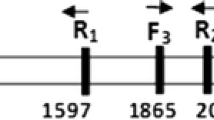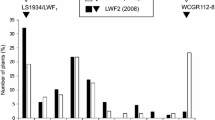Abstract
Fusarium wilt, caused by Fusarium oxysporum f. sp. melonis (F.o.m), is a worldwide soil-borne disease of melon (Cucumis melo L.). The most effective control measure available is the use of resistant varieties. Resistance to races 0 and 2 of this fungal pathogen is conditioned by the dominant gene Fom-1. An F2 population derived from the ‘Charentais-Fom1’ × ‘TRG-1551’ cross was used in combination with bulked segregant analysis utilizing the random amplified polymorphic DNA (RAPD) markers, in order to develop molecular markers linked to the locus Fom-1. Four hundred decamer primers were screened to identify three RAPD markers (B17649, V01578, and V061092) linked to Fom-1 locus. Fragments amplified by primers B17649 and V01578 were linked in coupling phase to Fom1, at 3.5 and 4 cM respectively, whereas V061092 marker was linked in repulsion to the same dominant resistant allele at 15.1 cM from the Fom-1 locus. These RAPDs were cloned and sequenced in order to design primers that would amplify only the target fragment. The derived sequence characterized amplified region (SCAR) markers SB17645 and SV01574 (645 and 574 bp, respectively) were present only in the resistant parent. The SV061092 marker amplified a band of 1092 bp only in the susceptible parent. These markers are more universal than the CAPS markers developed by Brotman et al. (Theor Appl Genet 10:337–345, 2005). The analysis of 24 melon accessions, representing several melon types, with these markers revealed that different melon types behaved differently with the developed markers supporting the theory of multiple, independent origins of resistance to races 0 and 2 of F.o.m.


Similar content being viewed by others
References
Álvarez JM, González-Torres R, Mallor C , Gómez-Guillamón ML (2005) Potential sources of resístanse to Fusarium wilt and powdery mildew in melons. HortScience 40(6):1657–1660
Arnedo-Andrés MS, Gil-Ortega RM, Arteaga L, Hormaza JI (2002) Development of RAPD and SCAR markers linked to the Pvr4 locus for resistance to PVY in pepper (Capsicum annuum L.). Theor Appl Genet 105(6–7):1067–1074
Banihashemi Z, DeZeeuw DJ (1975) The behavior of Fusarium oxysporum f. sp. melonis in the presence and absence of host plants. Phytopathology 65:1212–1217
Brotman Y, Silberstein L, Kovalski I, Périn C, Dogimont C, Pitrat M, Klingler J, Thompson GA, Perl-Treves NKR (2002) Resistance gene homologues in melon are linked to genetic loci conferring disease and pest resistance. Theor Appl Genet 104:1055–1063
Brotman Y, Kovalski I, Dogimont C, Pitrat M, Portnoy V, Perl-Treves NKR (2005) Molecular markers linked to papaya ring spot virus resistance and Fusarium race 2 resistance in melon. Theor Appl Genet 110:337–345
Burger Y, Katzir N, Tzuri G, Portnoy V, Saar U, Shriber S, Perl-Treves NKR, Cohen R (2003) Variation in the response of melon genotypes to Fusarium oxysporum f. sp. melonis race 1 determined by inoculation tests and molecular markers. Plant Pathol 52:204–211
Danin-Poleg Y, Burger Y, Schreiber S, Katzir N, Cohen R (1999) Identification of the gene for resistance to Fusarium wilt races 0 and 2 in Cucumis melo Dulce. Cucurb Genet Coop Rep 22:19–20
Danin-Poleg Y, Reis N, Baudracco-Arnas S, Pitrat M, Staub JE, Oliver M, Arus P, de Vicente MC, Katzir N (2000) Simple sequence repeats in Cucumis mapping and map merging. Genome 43:963–974
Danin-Poleg Y, Tadmor Y, Tzuri G, Reis N, Hirschberg J, Katzir N (2002) Construction of a genetic map of melon with molecular markers and horticultural traits, and localization of genes associated with ZYMV resistance. Euphytica 125:373–384
Doyle JJ, Doyle JL (1987) A rapid isolation procedure for small quantities of fresh leaf tissue. Phytochem Bull 19:11–15
Ficcadenti N, Sestili S, Annibali S, Campanelli G, Belisario A, Maccaroni M, Corazza L (2002) Resistance to Fusarium oxysporum f. sp. melonis race 1,2 in muskmelon lines Nad-1 and Nad-2. Plant Disease 86(8):897–900
Garcia-Mas J, Van Leeuwen H, Monfort A, de Vicente MC, Puigdomenech P, Arus P (2001) Cloning and mapping of resistance gene homologues in melon. Plant Sci 161:165–172
Gutierrez N, Avila CM, Rodriguez-Suarez C, Moreno MT, Torres AM (2007) Development of SCAR markers linked to a gene controlling absence of tannins in faba bean. Mol Breed 19:305–314
Joobeur T, King JJ, Nolin SJ, Thomas CE, Dean RA (2004) The Fusarium wilt resistance locus Fom-2 of melon contains a single resistance gene with complex features. Plant Journal 39(3):283–297
Kosambi DD (1994) The estimation of map distance from recombination values. Ann Eugen 12:172–175
Koveza OV, Gostimsky SA (2005) Development and study of SCAR markers in Pea (Pisum sativum L.). Russ J Genet 41(11):1254–1261
Lander ES, Green P, Abrahamson J, Barlow A, Daley MJ, Lincoln SE, Newberg L (1987) MAPMAKER: an interactive computer package for constructing primary genetic linkage maps of experimental and natural populations. Genomics 1:174–181
Leach JG, Currence TM (1938) Fusarium wilt of muskmelons in Minnesota. Minnesota Agric Exp Station Tech Bull 129:32
Leister D, Kurth J, Laurie DA, Yano M, Sasaki T, Devos K, Graner A, Shulze-Lefert P (1998) Rapid reorganization of resistance gene homologues in cereal genomes. Proc Natl Acad Sci USA 95:370–375
Michelmore RW, Paran I, Kesseli RV (1991) Identification of markers linked to disease-resistance genes by bulked segregant analysis: a rapid method to detect markers in specific genomic regions by using segregating populations. Proc Natl Acad Sci USA 88:9828–9832
Ohmori T, Murta M, Motoyoshi F (1996) Molecular characterization of RAPD and SCAR markers linked to the Tm1 locus in tomato. Theor Appl Genet 92:151–156
Paran I, Michelmore RW (1993) Development of reliable PCR based markers linked to downy mildew resistance genes in lettuce. Theor Appl Genet 85:985–993
Perchepied L, Pitrat M (2004) Polygenic inheritance of partial resistance to Fusarium oxysporum f. sp. melonis race 1.2 in melon. Phytopathology 94(12):1331–1336
Périn C, Hagen S, De Conto V, Katzir N, Danin-Poleg Y, Portnoy V, Baudracco-Arnas S, Chadoeuf J, Dogimont C, Pitrat M (2002) A reference map of Cucumis melo based on two recombinant inbred line populations. Theor Appl Genet 104:1017–1034
Risser G (1987) Controversy on resistance to fusarium wilt in ‘Perlita’ (Cucumis melo L.). Cucurb Genet Coop Rep 10:60–63
Risser G, Banihashemi Z, Davis DW (1976) A proposed nomenclature of Fusarium oxysporum f. sp. melonis races and resistance genes in Cucumis melo. Phytopathology 66:1105–1106
Sambrook L, Fritsch EF, Maniatis T, (1989) Molecular cloning: a laboratory manual, 2nd edn. Cold Spring Harbor Laboratory, Cold Spring Harbor, New York
Singh M, Chaudhary K, Singal HR, Magill CW, Boora KS (2006) Identification and characterization of RAPD and SCAR markers linked to anthracnose resistance gene in sorghum [Sorghum bicolor (L.) Moench]. Euphytica 149:179–187
Sobir T, Ohmori M, Motoyoshi F (2000) Molecular characterization of the SCAR markers tightly linked to the Tm-2 locus of the genes in Lycopersicon. Theor Appl Genet 101:64–69
Tanksley SD (1983) Molecular markers in plant breeding. Plant Mol Biol Rep 1:3–8
Wang YH, Thomas CE, Dean RA (2000) Genetic mapping of a Fusarium wilt resistance gene Fom-2 in melon (Cucumis melo L.). Mol Breed 6:379–389
Wechter WP, Whitehead MP, Thomas CE, Dean RA (1995) Identification of a randomly amplified polymorphic DNA marker linked to the Fom-2 fusarium wilt resistance gene in muskmelon MR-1. Phytopathology 85:1245–1249
Yu YG, Buss GR, Maroof MAS (1996) Isolation of a superfamily of candidate disease resistance genes in soybean based on a conserved nucleotide-binding site. Proc Natl Acad Sci USA 93:11:751–756
Zheng XY, Wolff DW (2000) Development of a SCAR marker associated with Fusarium wilt resistance and the evidence of its segregation with the Fom-2 gene in melon (Cucumis melo L.). Subtropical Plant Sci 52:1–7
Zheng XY, Wolff DW, Baudracco-Arnas S, Pitrat M (1999) Development and utility of cleaved amplified polymorphic sequences (CAPS) and restriction fragment length polymorphisms (RFLPs) linked to the Fom-2 fusarium wilt resistance gene in melon (Cucumis melo L.). Theor Appl Genet 99:453–463
Zink FW, Gubler WD (1985) Inheritance of resistance in muskmelon to Fusarium wilt. J Am Soc Hort Sci 110:600–604
Zitter TA (1999) Fusarium wilt of melon, a worldwide problem in temperate and tropical regions. Acta Hortic 492:157–160
Zuniga TL, Zitter TA, Gordon TR, Schroeder DT, Okamoto D (1997) Characterization of pathogenic races of Fusarium oxysporum f. sp. melonis causing Fusarium wilt of melon in New York. Plant Dis 81:592–596
Acknowledgements
This study was funded by the grant AGL2005-03850-C02-02 from the Spanish Ministry of Education and Science (MEC). A. Oumouloud acknowledges a fellowship from the IAECI (Spanish Foreing Affaires Ministry). M.S. Arnedo-Andrés was supported by a “INIA-CCAA” research contract from the Spanish MEC. The authors wish also to thank Dr. A. Lopez-Sesé from E.E. La Mayora (CSIC, Spain) for her kind assistance in mapping the molecular markers.
Author information
Authors and Affiliations
Corresponding author
Rights and permissions
About this article
Cite this article
Oumouloud, A., Arnedo-Andres, M.S., Gonzalez-Torres, R. et al. Development of molecular markers linked to the Fom-1 locus for resistance to Fusarium race 2 in melon. Euphytica 164, 347–356 (2008). https://doi.org/10.1007/s10681-008-9664-y
Received:
Accepted:
Published:
Issue Date:
DOI: https://doi.org/10.1007/s10681-008-9664-y




